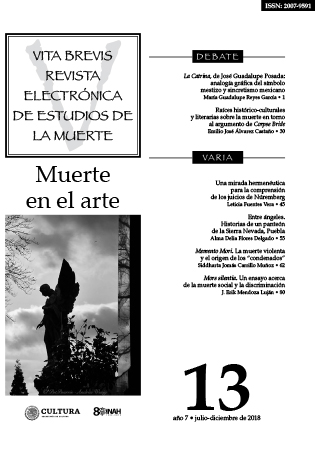Raíces histórico-culturales y literarias sobre la muerte en torno al argumento de Corpse Bride
Palabras clave:
Tim Burton, bodas de ultratumba, leyendas, donjuanismo, EsproncedaResumen
El guion de la película Corpse Bride, de Tim Burton, se sustenta en una leyenda de origen judío en la que se celebra una boda de ultratumba. A partir de este punto se comentan distintos aspectos literarios sobre dicha leyenda y las variantes de su permanencia histórica. Por otro lado, se muestra cómo el guion de la película se aparta en un determinado momento de la leyenda para tomar rasgos del tema literario del donjuanismo, habiendo un especial paralelismo con El estudiante de Salamanca de José de Espronceda, lo cual permite evitar un final trágico.
Descargas
Citas
Huang, Hua-Lun, The Missing Girls and Women of China, Hong Kong, and Taiwan: A Sociological Study of Infanticide, Forced Prostitution, Political Imprisonment, “Ghost Brides”, Runaways and Thrownaways, 19002000, Jefferson, McFarland & Company, 2012.
Ikels, Charlotte, “Parental Perspectives on the Significance of Marriage”, Journal of Marriage and Family, núm. 47 (2), 1985, pp. 253-264.
Klier, John Doyle, y Shlomo Lambroza (eds.), Pogroms: Anti-Jewish Violence in Modern Russian History, Cambridge, Cambridge University Press, 2004.
Martin, Diana, “Chinese Ghost Marriage”, en H. bAkeR y S. Feuchtwang (eds.), An Old State in New Settings: Studies in the Social Anthropology of China in Memory of Maurice Freedman, Oxford, JASO, 1991, pp. 25-43.
Noyes, Deborah, Encyclopedia of the End, Nueva York, Houghton Mifflin Company, 2008.
Page, Edwin, Gothic Fantasy: The Films of Tim Burton, Londres, Marion Boyars Publishers, 2007.
Pfefferman, Naomi, “Tim Burton’s Corpse Bride has Jewish bones”, en The Jewish News of Northern California, 16 de septiembre de 2005, recuperado de: http://www.jweekly.com/2005/09/16/tim-burton-s-corpse-bride-has-jewish-bones/ consultada el 26 de enero de 2017.
Perón Sobero, Macarena, “Tim Burton y el expresionismo alemán”, Creación y Producción en Diseño y Comunicación, núm. 35, 2010, p. 115-117.
Poznar, Walter, “Orpheus Descending: Love in Vertigo”, Literature/Film Quarterly, núm. 17 (1), 1989, pp. 59-65.
Salisbury, Mark (ed.), Burton on Burton, Londres, Faber, 2006.
Schroeder, David, Hitchcock´'s Ear: Music and the Director´'s Art, Nueva York, Continuum, 2012.
Schwartz, Howard, Reimagining the Bible: The Storytelling of the Rabbis, Oxford, Oxford University
Press, 1998.
Schwartz, Howard (ed.), Lilith’s Cave: Jewish Tales of the Supernatural, Oxford, Oxford University Press, 1988.
Schwartze, Lucas J., “Grave Vows: A Cross-Cultural Examination of the Varying forms of a Ghost Marriage among Five Societies”, Nebraska Anthropologist, núm. 60, 2010, pp. 82-95.
Topley, Marjorie, Cantonese Society in Hong Kong and Singapore: Gender, Religion, Medicine and Money, Hong Kong, Hong Kong University Press, 2011.
Tseng, Wen-Shing, y Jing Hsu, Culture and Family: Problems and Therapy, Nueva York, Haworth Press, 1991.
Verdaguer, Jacinto, La Atlántida (trad. de Melchor de Palau), Barcelona, Estampa de Fidel Giró, 1886.
Williams, Victoria, Celebrating Life Customs around the World: From Baby Showers to Funerals, vol. 1. Santa Bárbara, Abc-Clío, 2017.
Yao, Ping, “Until Death Do Us Unite: Afterlife Marriages in Tang China, 618-906”, Journal of Family History, núm. 27 (3), 2002, pp. 207-226.



